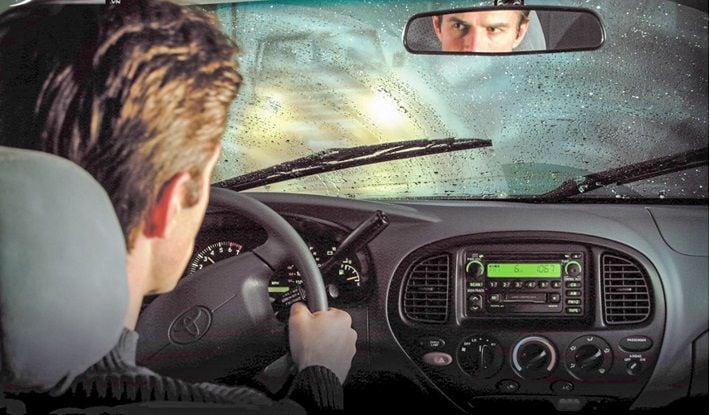Hold the steering wheel tight
Driving on slippery roads with many deep puddles makes the driver always feel like the car is jerking back, causing panic. Therefore, you need to stay calm, hold the steering wheel tightly and continue moving the car on your journey.

Slow down and keep your distance from other vehicles.
When the weather is bad, it rains a lot, visibility will be limited. At the same time, slippery roads also reduce braking efficiency. Therefore, you should proactively reduce speed by at least 20% on familiar roads and reduce to the maximum on unfamiliar roads at intersections or curves, etc. This will help you observe better and handle easily, without having to brake suddenly when encountering unexpected situations.
In addition, keeping a safe distance from other vehicles is also very important when driving. It helps you have a gap to help the car brake slowly when the car above suddenly brakes suddenly. The distance considered safe between cars when driving on slippery roads is 30m.
Don't steer hard.
If you are unfortunate enough to lose control of the vehicle, you need to stay calm and absolutely do not continue to steer. What you need to do now is to hold the steering wheel firmly, release the accelerator and apply the brakes until the vehicle comes to a complete stop.
When the car has skidded on a slippery road, if there is no ABS braking system, the driver must not use the brakes anymore. On the contrary, when the car has this system, the driver must brake firmly to overcome the skid. Finally, release the accelerator gently to steer in the direction the driver wants.
Follow the tire tracks of the car in front.
If you are driving on a slippery road, following the tire tracks of the car in front is a wise choice. Because the tire tracks of the car in front have “cleared the way” and helped you navigate. In addition, the road in those tire tracks has limited the adhesion between rainwater and dirt, sand on the road surface. Therefore, that part of the road is less slippery.
Actively stop the car when it skids
In case of adverse weather conditions such as heavy rain or slippery roads, stopping the vehicle is necessary to ensure the safety of both the driver and other road users. When deciding to stop, the driver should choose an area on the side of the road with a suitable space, always turn on the headlights and warning lights so that other people and vehicles can recognize their car.

Do not brake or turn suddenly
Drivers should be absolutely careful not to brake or turn suddenly if the vehicle loses traction due to wet road conditions. This can cause the vehicle to skid, which is extremely dangerous for the driver and other road users.
Proactively reduce speed and keep a safe distance from other vehicles.
When driving in bad weather, keep a safe distance from other vehicles and reduce speed. With a vehicle equipped with ABS, when the vehicle skids, the driver only needs to brake, hold and steer. The anti-lock braking system will create a series of clicks and releases so that the driver can brake and maintain steering, quickly getting the vehicle out of the slippery area.
Open large radius when cornering
When driving on slippery roads, the time of cornering must be handled precisely to ensure safety. And opening a large radius when cornering is necessary. Because if the corner is too narrow, the car can easily skid the rear wheels, causing danger when driving.
Run in the middle of the road
Normally, on roads, the center of the road is higher than the two sides. Therefore, if it rains or the road is muddy, they tend to drift to the two edges. Therefore, choosing the center of the road to drive will help the vehicle limit water from flooding the wheels or mud sticking, making the vehicle more slippery.
Source




![[Photo] Ho Chi Minh City holds funeral for former President Tran Duc Luong](https://vphoto.vietnam.vn/thumb/1200x675/vietnam/resource/IMAGE/2025/5/24/9c1858ebd3d04170b6cef2e6bcb2019e)


![[Photo] The Government Standing Committee works with ministries and branches on the real estate market situation.](https://vphoto.vietnam.vn/thumb/1200x675/vietnam/resource/IMAGE/2025/5/24/e9b5bc2313d14c9499b8c9b83226adba)



















![[Photo] Party and State leaders visit former President Tran Duc Luong](https://vphoto.vietnam.vn/thumb/1200x675/vietnam/resource/IMAGE/2025/5/24/960db9b19102400e8df68d5a6caadcf6)





































































Comment (0)